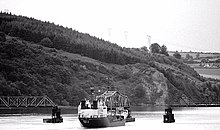Barrow Bridge
| Barrow Bridge | |
|---|---|

A photo of Barrow Bridge open with a boat passing through.
|
|
| Coordinates | 52°24′49″N 6°56′48″W / 52.413630°N 6.946583°WCoordinates: 52°24′49″N 6°56′48″W / 52.413630°N 6.946583°W |
| Carries | Trains |
| Crosses | River Barrow |
| Locale | County Kilkenny and County Wexford |
| Other name(s) | Barrow Viaduct Barrow Railway Bridge |
| Maintained by | Iarnród Éireann |
| Characteristics | |
| Design | pratt truss |
| Material | steel |
| Total length | 2,131 ft (650 m) |
| Clearance below | 26 ft (7.9 m) |
| History | |
| Architect | Sir Benjamin Baker |
| Constructed by | Sir William Arrol |
| Fabrication by | Sir William Arrol and Co. |
| Construction start | 1902 |
| Construction end | 1906 |
| Opened | 1906 |
| Closed | 2010 |
| Replaces | 1887 viaduct |
Barrow rail bridge, (or the Barrow viaduct), is a pratt truss type of railway bridge that spans the river Barrow between County Kilkenny and County Wexford in the south east of Ireland. This rural landmark with a length of 2,131 ft (650 m) is the longest bridge on the river. It was second longest bridge in Ireland and the third longest rail bridge in the British Isles. Designed by Sir Benjamin Baker and built by the firm of Sir William Arrol. It is known locally as Barrow bridge.
Part of a development to improve cross-channel passenger services. Incorporating a 1887 viaduct, the steel truss single track bridge was built between 1902 and 1906 by English and Irish railway companies, it operated passenger services between Rosslare Harbour and Waterford until 2010. It is maintained by Iarnród Éireann, the Irish rail operator.
This bridge is one of six rail bridges of 45 bridges on the Barrow. It spans the river just upstream from its confluence with another of the three sisters the River Suir. Close to Great Island Power Station near Cheekpoint. It is the last bridge on the river Barrow and opens approximately twice daily to permit shipping and yachts to pass upstream to New Ross.
It is an important element of the early twentieth-century transport heritage of Kilkenny and Wexford. Part of the development of the Dublin, Wicklow and Wexford Railway. Built as a joint venture between the "Fishguard and Rosslare Railways & Harbors Company (FRR + H Co)" and the Great Southern and Western and Great Western. To improve cross-channel passenger services the Rosslare Strand to Waterford. After the Tay Bridge and Forth Bridge it was the third longest rail bridge in the British Isles.
...
Wikipedia

